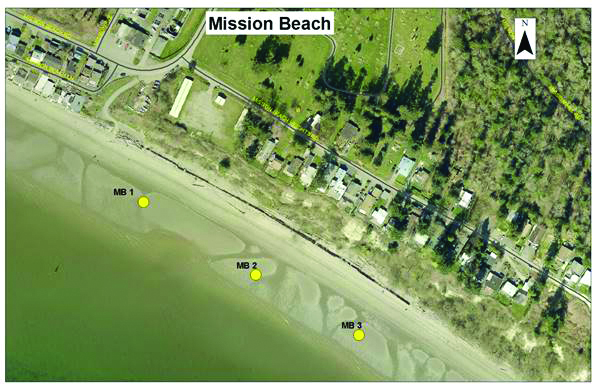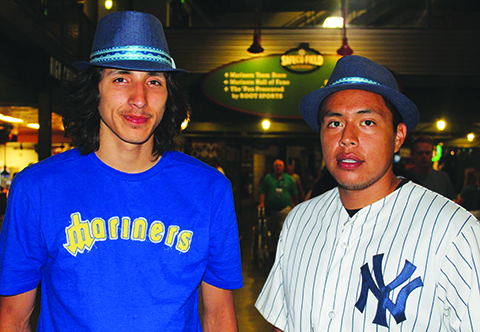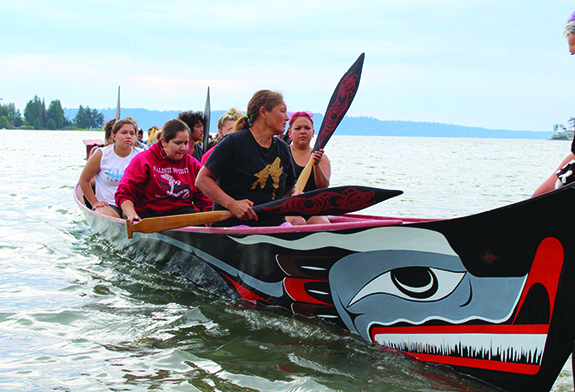Please use the following link to download the August 9, 2017 issue of the syəcəb:
https://www.dropbox.com/s/9eob2g7f0xpgad2/August%209%202017%20sy%C9%99c%C9%99b.pdf?dl=0
syəcəb
Please use the following link to download the August 9, 2017 issue of the syəcəb:
https://www.dropbox.com/s/9eob2g7f0xpgad2/August%209%202017%20sy%C9%99c%C9%99b.pdf?dl=0
By Valerie Streeter, Tuallip Tribes Natural Resources Dept.
This summer, WSU Beach Watchers volunteers are monitoring the quality of water at Mission Beach each week until August 29. Harvey Eastman at the Tulalip Water Quality Lab analyzes the water samples. So far, the beach has been sampled eight (8) times.
The results show that bacteria levels in the water are low, well below the threshold limit for swimming, which means that the water is clean! The graphs below show the average result from the three beach sampling stations for this year as well as last year. The red line shows the bacteria threshold limit and the blue line is the amount of bacteria in the water at Mission Beach. If bacterial levels are above the threshold limit, there are more chances for skin infections or gastrointestinal illness from too much pollution.


By Micheal Rios, Tulalip News
Team Washington’s 19U men’s basketball team (led by Tulalip tribal members Bryce Juneau, Robert Miles and Darion Joseph) participated in a highly competitive, week long tournament at the 2017 Native American Indigenous Games hosted in Toronto, Canada. Dubbed “the Native Olympics”, Team Washington represented their tribal communities proudly while coming up clutch game after game on their quest for Gold.
After dropping their opening game in pool play, a 69-73 loss to Wisconsin, the team had little doubt they would bounce back. In fact, talking to the players immediately after they were eager to get back on the court and prove they were much better than the first game showed. Their coach echoed that sentiment.
“They needed those first few quarters together versus quality competition to figure how to play as a team,” reflected Coach Harold Joseph after the opening game loss. “In that second half they got comfortable and everything started to click both offensively and defensively. That momentum will carry over to our remaining games of pool play for sure. These boys still expect to rally and make the gold medal round.”
They were right. The momentum and confidence showed big time the very next game when Washington played Ontario, the host team, in a jam-packed gym of Ontario fans. The loud and cheerful fans fell silent as they watched Washington execute its offense easily over and over against Ontario’s defense. Leading by double-digits most of the game, Washington won 71-55. They were led by Darion Joseph’s game high 18 points.
Only hours later Washington was back in action, this time with a matchup with Northwest Territories out of Canada. It was a complete and utter smackdown served up by Team Washington. With a blazing pace of play and all-go attitude, they boys were scorching hot on offense. They led a whopping 47-9 at halftime on route to a 90-28 victory. This time it was Bryce Juneau scoring a game high 19 points, followed by 17 points from Robert Miles.
Coming off back-to-back wins that showcased the style of play Team Washington (2-1) expected to play, they would have their medal tested versus Team Manitoba (3-0). Playing another team from Canada meant another gym completely full of fans rooting against them, but Washington relished it.
In order to win their pool, make it to the semi-final round, and keep hopes alive of playing for a gold medal, Washington had to beat undefeated Manitoba. The game was a true back and forth battle. Both teams were bringing it on both ends. At halftime Washington trailed 37-39. The teams continued to trade buckets and answer each other’s scoring run with an equalizing string of points. It was only fitting that at the end of regulation the score was 73-73, forcing overtime.
Washington connected on back-to-back 3-pointers by Robert Miles and Tre Williams to open the overtime period. Manitoba again answered back to tie the game at 79-79. Darion and Bryce then took over with a series of pick and roll plays that gave their team the winning advantage, while silencing the gym of ruckus Manitoba fans. The 87-83 win put Washington on a three-game winning streak, but most importantly it meant they won their pool and would play in the semi-final round.
On Friday, July 21 Team Washington (3-1) played an early morning, semi-final game versus fellow west coast team Vancouver B.C. (3-1). A berth to the gold medal game was on the line.
In the first half, each team played to its strength. Washington looked to get the ball down low to its bigger, stronger forwards while B.C. looked to push the ball in transition at every opportunity and beat Washington down court. The Tulalip led team were down 36-38 at halftime and watched the deficit grow to 9 points when they trailed 48-57 near the end of the 3rd quarter.
It was in the game’s crucial moments that Robert Miles was at his best. He was a monster on defense, getting his hands on every loose ball and deflected any pass that came his way. Then on offense he got red hot when his team needed it most. He hit a pair of 3-pointers and several free-throws that gave Washington a 67-65 lead with five-minutes to play. From there are Bryce and Darion again ran their two man game to perfection. Darion scored on series of pick and rolls that sealed the W for Team Washington, 82-76. Incredibly, the three Tulalip boys combined to score 21 of the teams 23 points scored in the deciding 4th quarter.
Washington now (4-1) got a few hours to rest and rehydrate for an impending matchup with Team Minnesota (5-0) in the Indigenous Games basketball finals. Minnesota led the entire competition with an astounding 105 points per game average, while Washington boasted a stifling defense that only allowed 63 points per game to their opponents. It would be a battle of contrasting styles with the gold medal on the line.
As basketball fans and players from various team across North America filled the stands to watch the gold medal game, Team Washington put on a defensive clinic. They had played zone defense for nearly the entire competition to this point, but against Minnesota’s shooting arsenal Washington switched to an aggressive man-to-man defense. The strategy paid off huge as the quicker and taller Washington defenders contested every single shot and cut off every passing lane. At halftime Washington led 48-36.
There is a classic saying “the best offense is a good defense”. Team Washington proved that saying true. In the 3rd quarter, with center Mike Leslie in the game coming up with big time blocks and guards Bryce and Rob getting steals, Washington turned several Minnesota turnovers into easy scoring opportunities. Up 20 points, 75-55, the game was out of reach for a Minnesota team that couldn’t solve Washington’s lockdown defense. When the final game buzzer sounded Washington had won convincingly, 93-77, to claim the title as best Indigenous basketball team in North America.
Following the medal ceremonies, where the boys and their coaches were beaming with pride and excitement as they were each presented with a gold medal, the Tulalip tribal member athletes reflected on their North American Indigenous Games experience.
“I feel great having been given the opportunity to represent Team Washington and my tribe,” said Bryce Juneau. “Losing our opening game got us going, it was a punch in the mouth that we needed to regroup and focus in on playing at our best. Seemed like every game we played we had a gym full of fans rooting on the other team. We used that as extra motivation to play well and silence those fans. We came a long way from Tulalip to play at these Toronto Games and to win the gold is an amazing feeling.”
“To win the gold with this group of teammates for Team Washington is great. Just thinking of all the basketball I’ve played with Bryce and Darion since we were kids and now we’re here as champions,” reflected Robert Miles, who is now a two-time gold medalist after winning gold at the last edition of NAIG. “I’ll never forget being here in Toronto the past week and getting to experience the city and culture with my team. From all the sites, food, and art in downtown Toronto to going to Niagara Falls, we made a lot of memories.”
“As a team, being in Toronto, we were all in a new place, exploring together and having fun. After that opening game loss we kept together, we knew we could fight back because we were here to win the gold medal. And we did!” declared Darion Joseph. “Participating in the Indigenous Games and to represent your tribe is an amazing experience. To all the young kids back home in Tulalip my advice is to keep working hard to craft your skills and never give up, you can be at the next Indigenous Games representing Team Washington.”
By Kalvin Valdillez, Tulalip News
Over sixty future Tulalip leaders participated in the first week of the 22nd Annual Lushootseed Language Camp. The kids learned the traditional Coast Salish language and Tulalip culture during the week of July 17-21. Hosted by the Tulalip Lushootseed Language Department, the summertime camp is held twice during the month of July and is open to Tulalip youth age five to twelve.
The kids are treated to five fun days of culture in which they learn the traditional language, teachings and stories of Tulalip. The camp utilizes several interactive activity stations to teach about Tulalip’s traditional way of life. Campers become familiar with the words while playing games and using modern technology. In addition to studying Lushootseed, campers also learn traditional Tulalip dances and songs.
“One of the songs we sang was the Welcome Song and it was Harriet Shelton Dover’s song,” stated Language Camp Instructor, Cary Michael Williams. “We also sang the Killer Whale Song, which was Ray Fryberg and Tony Hatch’s song they put together and brought forward to the Lushootseed Department.”
Each year, the Lushootseed Department honors a Tulalip member by teaching the youth about their work within the Tulalip culture. Last year the camp was dedicated to Harriett Shelton-Dover, this year the camp is dedicated to her son and Tulalip Elder, Wayne Williams.
“We always think of somebody to honor and dedicate the camp to and this year Wayne Williams came to mind,” explains Lushootseed Language Teacher, Natosha Gobin. “We know that he’s done so much for our community with preserving our teachings as well as everything he’s donated to the Hibulb Cultural Center. We felt it’s very important to acknowledge him while he’s here because a lot of times people don’t get acknowledged until they’re gone, and he’s still here with us so we want to honor him.”
Throughout the week, the youth rehearse a play based on a traditional Tulalip story. The play is performed for the community during the closing ceremony on the last day of camp. In honor of Wayne Williams, the Language Campers reenacted Wayne’s story Killer Whale and Two Boys.
Language Camp continues to grow; previously the department would anticipate about fifty participants each summer. However, due to increasing interest, the camp has seen an increase of fourteen participants each week in the past two years.
Young Tulalip tribal members and siblings, Natalie and Carsten Nordahl, travel from Boston every summer to attend Language Camp. According to their father, Natalie excitedly awaited the year her younger brother was old enough to enroll, in order to experience the cultural camp together. The kids have returned each summer, making this their third trip to Tulalip.
“I love that we get to learn about our culture and the language of our Tribe. My favorite part is learning the language and just being a part of this experience,” Natalie expressed. Carsten added, “My favorite part about camp was playing the games!”
Parents, grandparents, aunties and uncles gathered at the Betty J. Taylor Early Learning Academy Gym on July 21, for the 22nd Annual Lushootseed Language Camp closing ceremony. The youth showcased their teachings to the community by performing the songs and the play in Lushootseed.
“As a parent it’s important for my son to attend language camp because it was something I was able to do as a child and it’s important to carry on the songs and the teachings from our ancestors,” states Lushootseed Camp parent and Tulalip tribal member Samantha Chavez.
After performing Killer Whale and Two Boys, the youth gave handmade gifts, such as weavings and necklaces, to every guest in attendance. Over the span of twenty-two years, the camp has inspired numerous Tulalip youth to learn more about their culture. Many current Lushootseed Language Instructors, attended Language Camp when they were younger, including Tulalip tribal member Shelbi Hatch.
“Language Camp started before I was born actually, it was in ‘93 I think,” Shelbi recalls. “It’s a place for the kids to learn their culture and for everybody to get a view of what Tulalip is and how intact our culture and language still is. This gives them the utilities and the tools they need for later on in life. I feel more of a generational importance, I don’t feel like it’s me receiving the teachings, I feel like I’m giving it and these kids will be the ones to speak fluently.”
The Lushootseed department and the language campers displayed two paddles, with traditional artwork depicting the Killer Whale and Two Boys story that will be gifted to Wayne Williams and his sons.
“We keep trying to follow the teachings that Shelly Lacy and Auntie Joy [Lacy] laid out because this was part of their vision twenty-two years ago,” states Natosha while reflecting on a successful first week. “This is always the best time of the year for us. The kids have so much fun, the families are so grateful and it’s just a good time. We’re happy we’re able to keep this alive and keep it going.”
For more information about the Annual Lushootseed Language Camp please contact the Lushootseed Language Department at (360) 716-4499 or visit their website wwww.TulalipLushootseed.com
By Kalvin Valdillez, Tulalip News
On a beautiful warm summer evening, hundreds of tribal members from across Washington State traveled to Safeco Field to watch the Seattle Mariners take on the New York Yankees. Every summer the Mariners partner with the Emerald Queen Casino to present Salute to Native American Night, in which the baseball clubs celebrates Pacific Northwest Native American culture.
 The Mariners often present gifts on game nights, such as t-shirts and bobble heads, to fans that arrive early to the stadium. In honor of Native American Night, the baseball club gave away fedora hats designed with salmon, in traditional Coast Salish art, to the first 10,000 fans to enter Safeco. Several tribes received tickets to the game to disperse amongst their members. The majority of the Tulalip community sat together in section 149, near left field, creating a fun atmosphere with friends and family while enjoying America’s favorite pastime.
The Mariners often present gifts on game nights, such as t-shirts and bobble heads, to fans that arrive early to the stadium. In honor of Native American Night, the baseball club gave away fedora hats designed with salmon, in traditional Coast Salish art, to the first 10,000 fans to enter Safeco. Several tribes received tickets to the game to disperse amongst their members. The majority of the Tulalip community sat together in section 149, near left field, creating a fun atmosphere with friends and family while enjoying America’s favorite pastime.
The sold-out stadium contained a playoff-type energy as the fans were treated to a close and intense ball game. Mariner’s Second Baseman, Robinson Cano, hit a solo homerun in the bottom of the eighth that gave Seattle a 5-4 advantage. However, the Yankees came back to tie the game in the ninth inning. The game extended into extra innings, where the M’s we’re able to score a walk-off run to win the game, providing a thrilling victory for the fans of Seattle.
By Kalvin Valdillez, Tulalip News
Washington State’s one-hundredth anniversary inspired a cultural movement amongst Pacific Northwest Tribes in 1989. While planning for the State’s centennial celebration, Quinault tribal member, Emmett Oliver organized a traditional canoe pull across Elliot Bay to honor Washington’s Native American culture. The paddle influenced the tribes to continue their traditional practices by starting the annual summertime event known as Tribal Canoe Journeys.
For nearly thirty years Northwest tribes have participated in Tribal Journeys. While honoring the traditional mode of transportation, multiple tribes navigate the open waters in cedar dugout canoes and travel together from tribe to tribe until they reached their final landing destination. The tribes take turns hosting the event each year, marking their reservation the final destination. After all the canoes arrive, a weeklong celebration ensues in the form of traditional song, dance and storytelling. The Tribal Canoe Journey experience reconnects tribal members with their culture and promotes positive lifestyle choices.
 This year, the We Wai Kai Nation along with the Wei Wai Kum Nation are hosting Canoe Journey in Campbell River, BC. En route to the final landing destination, several Canoe Families entered the waters of Tulalip Bay on the evening of July 21, including Muckleshoot and Lummi. Tulalip Canoe Families also joined in on the ceremonial canoe landing, pulling alongside their guests. Once the Canoe Families were granted permission ashore, they enjoyed a meal before celebrating a night of culture during protocol at the Don Hatch Youth Center.
This year, the We Wai Kai Nation along with the Wei Wai Kum Nation are hosting Canoe Journey in Campbell River, BC. En route to the final landing destination, several Canoe Families entered the waters of Tulalip Bay on the evening of July 21, including Muckleshoot and Lummi. Tulalip Canoe Families also joined in on the ceremonial canoe landing, pulling alongside their guests. Once the Canoe Families were granted permission ashore, they enjoyed a meal before celebrating a night of culture during protocol at the Don Hatch Youth Center.
The Canoe Families, now traveling with Tulalip, continued their journey to Campbell River, departing from Tulalip Bay in the early morning of July 22. The canoes are expected to reach Campbell River by August 5, and festivities will continue through August 10.
Please use the following link to download the August 2, 2017 issue of the syəcəb:
https://www.dropbox.com/s/ho4i9jldxbhu2kh/August%202%202017%20sy%C9%99c%C9%99b.pdf?dl=0
US Senate to Vote on Healthcare Bill this week – Make your Voice Heard!